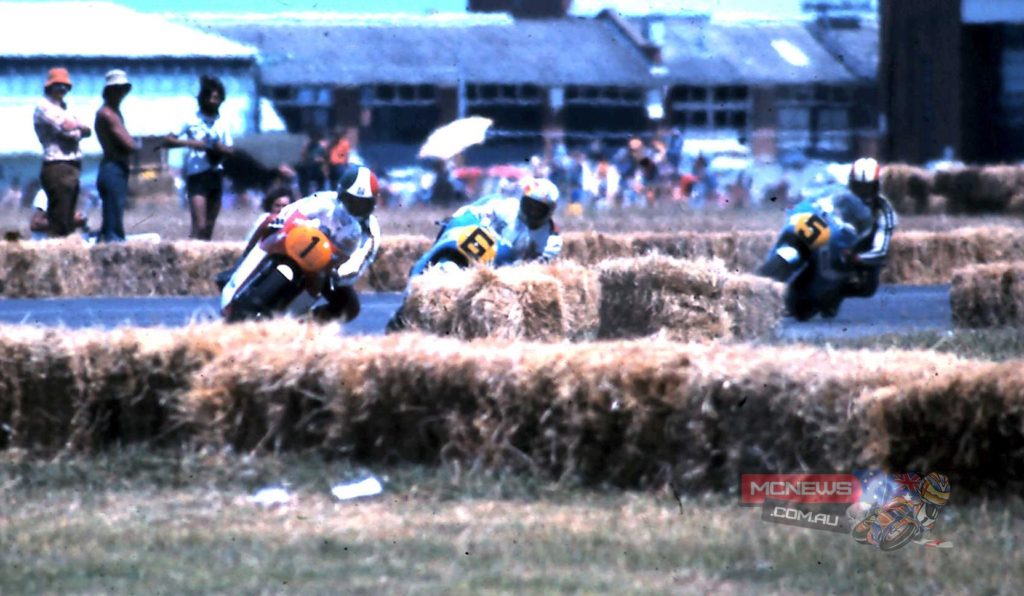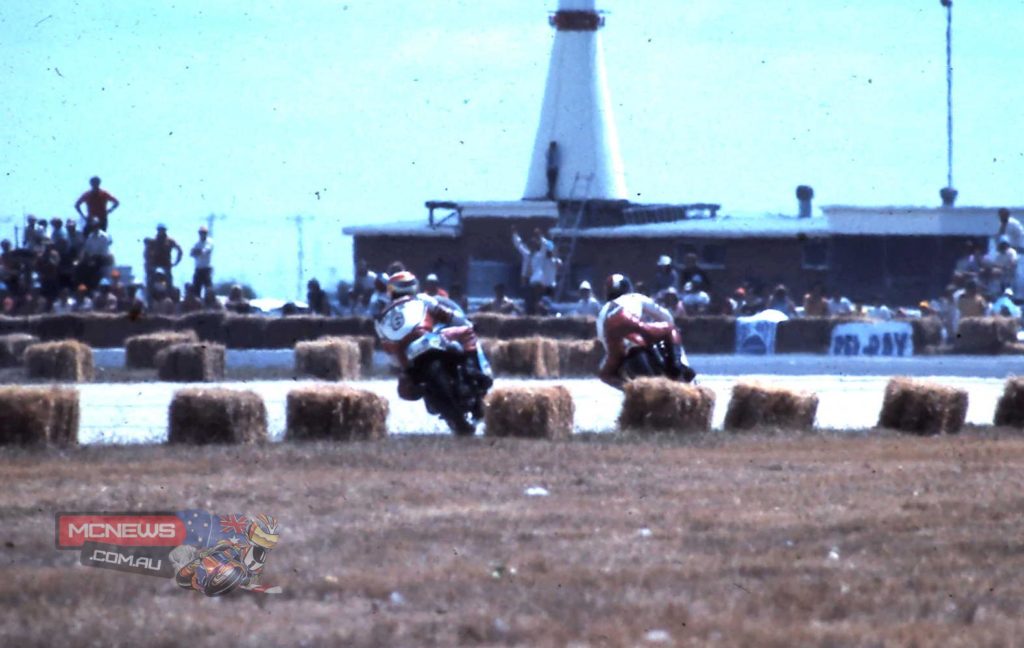I saw Blakey beat Ago – Laverton; The Australian TT
By Phil Hall
This week saw the 72nd birthday of the 9 times World Champion, Giacomo Agostini. Believed by many to be the greatest motorcycle racer that has ever lived, Ago, as he is nicknamed, is the darling of Italy, his adoration only being shared with Valentino Rossi whom many Italians see as the successor to Ago’s glory. Darkly handsome and debonair, Ago was the promoter’s dream and thousands (especially women) flocked to the circuits all over the world to watch the wizard on the MV do his thing.
However, Agostini’s two visits to Australia did not meet with the degree of success for which he and his fans had hoped. The first was in 1971 where, at Sydney’s Oran Park Raceway, he was beaten by the local hero, Bryan Hindle on a TZ350 Yamaha.
I was following car racing back then and don’t remember that event at all. But, by the time that Ago’s second visit to Australia was planned, I was already keenly watching proceedings. So, when it was announced that the he was coming to Australia to race, I pencilled it in as one not to be missed.
The first major race meeting that I attended was also one of the most significant race meetings of its era, though I could not have known that at the time. It was the Australian TT, held on a purpose built airfield circuit at the Laverton Air Force Base just outside of Melbourne. My wife and I travelled to Melbourne in our Renault 12 wagon, an uneventful progress except for the mandatory speeding fine for exceeding (by three kilometres an hour) the ludicrous blanket 100 km/h speed limit in Victoria. The fact that the Victorian police car allowed several Victorian registered cars to pass me at much higher speed than mine and chose to book my NSW registered car was purely coincidental (yeah, right).
My wife was, to quote the good book, great with child, our daughter arriving only two months after this excursion. This necessitated many stops along the way and also put paid to my grand plan of saving money by sleeping in the back of the wagon when we got to Melbourne. The weather turned poisonously hot for the whole weekend and economy was sacrificed for comfort and an air conditioned motel room!
The Australian TT was an event steeped in history and the 1976 meeting saw the revival of the event after a lapse of some years. Only one event in each country was allowed to use the coveted TT title and so the meeting was considered to be quite prestigious. It had originally been planned to have the TT at Phillip Island, but this was not possible, so the promoters, anxious for the best publicity possible, arranged with the RAAF to use the airfields and ancillary buildings at Laverton instead. A private company was formed to promote the meeting and this was to be the cause of much “agro” later as the company went broke when the meeting failed to make the expected profit. The result was that many of the overseas competitors found their bikes and equipment impounded by Customs until outstanding monies guaranteed by the promoters were paid.
This debacle went a long way towards ensuring that other overseas competitors were to be much less likely to accept invitations to ride in Australia for some years to come. But, while the meeting was a financial and organisational disaster, few could have foreseen this as the lead up to the meeting unfolded. The ultimate entry list looked like a smorgasbord of overseas talent such as had never been seen in the one place in Australia before.
Such a star-studded line up would not be seen again until the ’90′s when a fully fledged World Championship GP was held in Australia for the first time, but, that’s another story. Heading the entry list was the man upon whose name the organisers pinned their hopes of record crowds, the legendary Giacomo Agostini. After winning the 500cc Title for Yamaha the year before, Agostini had voted with his heart and not his head (hey, he’s Italian, remember?) and had returned to his beloved MV’s for another tilt (unsuccessful as time would tell) at the 500cc Title. Everyone knew that the MV’s were going to be uncompetitive; the smart money was on Yamaha. I suspect that Agostini knew too, but I think the cunning Count Agusta had offered his “favourite son” so much money to return to the fold that Ago simply couldn’t resist.
Here at Laverton, though, to use Aussie parlance, he was on a hiding to nothing. If he won, people could simply say, “Well, he’s the champ and so he should have.” If he lost, people would proclaim the one who beat him as a hero and he would forever more be remembered as “the man who beat Ago”. This was confirmed by the adulation surrounding Bryan Hindle who had beaten Ago at Oran Park in Ago’s only other trip to Australia some years before as previously mentioned.
The supporting races on the card were excellent with the Morbidelli Pair of Bianchi and Pileri winning the Ultra Lightweight (125cc) race and the 250 and 350 races both being won by the Italian Diemme Team. The Unlimited race was a cracker with local Hero, Gregg Hansford (KR750 Kawasaki) just beating American Pat Hennen on a “works” TR750 Suzuki. But it was the Senior (the 500cc) race that most had come to see. Could the great Ago be beaten?
When the flag dropped, Ago immediately went to the lead and held it narrowly until Lap 2 when he was passed by an unknown Kiwi called Stu Avant on one of the new RG500 Suzukis. Avant led for several laps, stunning both Ago and the crowd, most of whom had never even heard of him. It wasn’t to last, however, with the bike seizing and dumping the impudent Avant on the tarmac. Those couple of laps, however, were enough to catapult the young Kiwi from obscurity to fame and were to lead to much greater things. The rider that totally dominated the first Canberra Road Closure at Macarthur Park was the same Stu Avant, riding an RG 500 Suzuki for Dick Hunter.
Ago resumed the lead as the Suzuki challenge faded. Kiwi John Boote’s Suzuki had barely got off the line and was withdrawn immediately with over heating and John Woodley’s RG also seized while the talented Kiwi was holding fourth place on the first lap. It must be remembered that the bikes were totally new and not nearly enough was known here about how to fettle them and keep them reliable at this stage. Behind Ago the two Australian RG’s were still going great. Kenny Blake was holding second with Greg Johnson in third. I was unaware of the dramas that had affected the other entrants as the PA system was useless in both the areas where my wife and I spectated. However, even knowing little of who the riders were (apart from Ago), I was aware enough to barrack for the Aussies and I had met Kenny Blake and Jack Walters in the pits on the Saturday and something about the quiet and friendly manner of Blakey had impressed me even then.
Once it became clear that Blakey was closing on Ago, the crowd went wild (except for the partisan part of the crowd that was of Italian extraction or heritage, of course). People began shouting, urging Ken on, while others began to look despairing as the prospect of their idol being defeated became more likely.
I must add here that, where we were spectating on the Sunday, under the shade of the very few trees that existed on the base, there was a little Italian man and his wife. It seems that he had only come for one thing; to see, and more importantly to HEAR Ago’s MV Agusta. He came equipped with a little cassette recorder to which was attached and even smaller microphone and every time the MV came by, he would rush to the fence and hold out the microphone to record the glorious 4 stroke howl of the Italian thoroughbred. Once Ago had passed, he would go back under the trees again. Such a delightful cameo of Italian passion.
At the end of lap 9, entering the pit straight, Kenny outbraked Ago and established a narrow lead. Greg Johnson in what was probably his best ride either before or since, was closing on Ago also but was not in a position to pass and the laps were running out. Using all his talent and experience, Ago held on grimly, but it was not enough. Blake crossed the line the winner to the rapturous applause of the Victorian crowd.
Ago was close but soundly beaten in second and Johnson a fine third. The Victory Lap was pandemonium, spectators setting a Victorian precedent by mobbing their hero, breaking easily through the makeshift wire and star picket fences. A contemporary report summed up the winner much better than I so I’ll quote it, “The man of the hour was his usual happy self amid the excitement. Win or lose, World Champion or fellow Clubman, it seems that nothing can dent the Ken Blake’s even temperament.” There were some other exciting races that day and I’ll leave it to another time to chronicle them. But it is sufficient to say that I feel very privileged to be able to say, “I was at Laverton and saw Kenny Blake beat Agostini.”



























